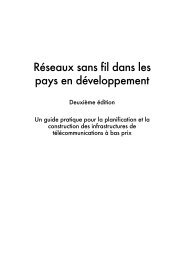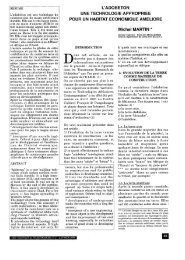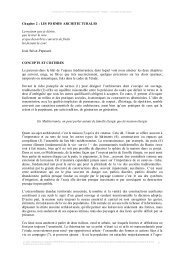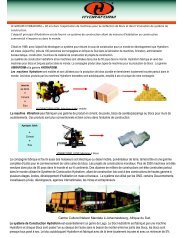ecoBEAM Building Manual - Habiter-Autrement
ecoBEAM Building Manual - Habiter-Autrement
ecoBEAM Building Manual - Habiter-Autrement
You also want an ePaper? Increase the reach of your titles
YUMPU automatically turns print PDFs into web optimized ePapers that Google loves.
<strong>ecoBEAM</strong><br />
<strong>Building</strong> <strong>Manual</strong><br />
November 2009<br />
Chelsea Brown, Shanice Jones, Bobby Luscinski, Trevor Olsen
Table of Contents<br />
If you are not receiving beams from an<br />
<strong>ecoBEAM</strong> factory, start at page 3.<br />
You will have to set up an on-site<br />
factory to make the beams yourself.<br />
If you are receiving beams from an<br />
<strong>ecoBEAM</strong> factory, start at page 8.<br />
You will be skipping the section about<br />
starting your own factory on site.<br />
Getting Started with <strong>ecoBEAM</strong>.................3<br />
Constructing a Beam..............................5<br />
Laying the Foundation............................8<br />
Framing a Wall....................................12<br />
Erecting the Structure..........................20<br />
Finishing your ecoBUILDING.................28<br />
<strong>ecoBEAM</strong> <strong>Building</strong> <strong>Manual</strong>
Getting Started with <strong>ecoBEAM</strong><br />
If you’re building your beams on site, you’ll<br />
need to set up an on-site factory. A good<br />
consideration is a metal container similar to<br />
the one shown above. It has enough room to<br />
hold all of the tools and supplies for the job,<br />
can be locked to prevent theft and will<br />
protect everything from the weather.<br />
A table needs to be set up to build the beams on.<br />
One similar to the table above should be used.<br />
The table has two barriers to clamp the wood<br />
to so that the width of the beam is<br />
consistent and correct.<br />
<strong>ecoBEAM</strong> <strong>Building</strong> <strong>Manual</strong> 3
Getting Started with <strong>ecoBEAM</strong><br />
This is a spool of metal that would be bent by<br />
the jig and dies to form the metal,<br />
structural section of the beams.<br />
For structural beams, a Zinc-Aluminum<br />
metal is used.<br />
For non-structural beams, galvanized steel is<br />
used.<br />
The picture on the left is a jig.<br />
The picture on the right shows<br />
dies that go in the jig.<br />
This system bends the metal used in the beams.<br />
<strong>ecoBEAM</strong> <strong>Building</strong> <strong>Manual</strong> 4
Constructing a Beam<br />
Materials and Tools Needed:<br />
Wood<br />
Metal<br />
Table<br />
Jig and dies<br />
Clamps<br />
Pliers<br />
Hammer<br />
Nails<br />
Step #1<br />
Clamp the wood to the table.<br />
<strong>ecoBEAM</strong> <strong>Building</strong> <strong>Manual</strong> 5
Constructing a Beam<br />
Step #2<br />
Step #3<br />
Bend the metal between the wood pieces.<br />
Starting at one end, begin nailing metal to wood.<br />
<strong>ecoBEAM</strong> <strong>Building</strong> <strong>Manual</strong> 6
Constructing a Beam<br />
Step #4<br />
Continue nailing until all of the bent metal is<br />
attached to the wood.<br />
<strong>ecoBEAM</strong> <strong>Building</strong> <strong>Manual</strong> 7
Laying the Foundation<br />
Materials and Tools Needed:<br />
Step #5<br />
Sand<br />
Cement<br />
Foundation sandbags<br />
Shovel<br />
String<br />
Stakes<br />
Measuring tape<br />
Clear land where the building is to be placed.<br />
<strong>ecoBEAM</strong> <strong>Building</strong> <strong>Manual</strong> 8
Laying the Foundation<br />
Step #6<br />
Step #7<br />
Place four posts where the corners<br />
of the building will go.<br />
Measure the distance diagonally<br />
between opposite posts.<br />
If the distances are the same,<br />
the building is square.<br />
<strong>ecoBEAM</strong> <strong>Building</strong> <strong>Manual</strong> 9
Laying the Foundation<br />
Step #8<br />
Step #9<br />
Tie a string around corner posts.<br />
Dig a foundation trench at least<br />
two sandbags wide.<br />
Trench must be at least two sandbags deep.<br />
Lay the foundation sandbags<br />
two wide along foundation lines.<br />
Stack bags level until there are<br />
two bags above the highest ground level.<br />
<strong>ecoBEAM</strong> <strong>Building</strong> <strong>Manual</strong> 10
Laying the Foundation<br />
Step #10<br />
Use water to wet the sandbags and<br />
set the cement.<br />
<strong>ecoBEAM</strong> <strong>Building</strong> <strong>Manual</strong> 11
Framing a Wall<br />
Materials and Tools Needed:<br />
Beams<br />
Red and white striped tape<br />
Plastic moisture barrier<br />
Hammer<br />
Nails<br />
Tape measure<br />
Dumpy level<br />
Parts of a Wall:<br />
Ceiling Beams<br />
Upright Beams<br />
Floor Beams<br />
Foundation<br />
<strong>ecoBEAM</strong> <strong>Building</strong> <strong>Manual</strong> 12
Framing a Wall<br />
Step #11<br />
Step #12<br />
Lay the floor and ceiling beam<br />
next to each other.<br />
Starting at one end, make a mark<br />
every 900 mm.<br />
<strong>ecoBEAM</strong> <strong>Building</strong> <strong>Manual</strong> 13
Framing a Wall<br />
Step #15<br />
Step #16<br />
The meter mark on each beam should be<br />
marked with a datum symbol as shown.<br />
Lay the upright beams perpendicular to the<br />
floor beams at the marks made in Step #4.<br />
<strong>ecoBEAM</strong> <strong>Building</strong> <strong>Manual</strong> 15
Framing a Wall<br />
Step #17<br />
Step #18<br />
Nail upright wall beams to floor beam.<br />
Use two nails; one into each piece of<br />
wood in the upright beams.<br />
Line up the upright beams with the<br />
marks made on the ceiling beam.<br />
<strong>ecoBEAM</strong> <strong>Building</strong> <strong>Manual</strong> 16
Framing a Wall<br />
Step #19<br />
Step #20<br />
Nail each upright beam to the ceiling beam.<br />
Use two nails; one nail into each piece<br />
of wood in the upright beam.<br />
Stretch the plastic moisture barrier<br />
around the floor beam.<br />
Nail the plastic into the last upright beam<br />
on each end of the wall section.<br />
<strong>ecoBEAM</strong> <strong>Building</strong> <strong>Manual</strong> 17
Step #<br />
Framing a Wall<br />
Step #21<br />
Step #22<br />
Measure the diagonals of the wall section.<br />
If the diagonals are equal,<br />
go on to the next step.<br />
If they aren’t equal,<br />
move the frame until they are.<br />
Nail a piece of wood across the upright beams.<br />
<strong>ecoBEAM</strong> <strong>Building</strong> <strong>Manual</strong> 18
Framing a Wall<br />
Step #23<br />
All windows and doors are framed on the top,<br />
bottom and both sides with regular, nonstructural<br />
<strong>ecoBEAM</strong>s.<br />
<strong>ecoBEAM</strong> <strong>Building</strong> <strong>Manual</strong> 19
Erecting the Structure<br />
Step #24<br />
Step #25<br />
Stand frame on foundation.<br />
Nail a board to frame to keep frame<br />
from falling over.<br />
<strong>ecoBEAM</strong> <strong>Building</strong> <strong>Manual</strong> 20
Erecting the Structure<br />
Step #26<br />
Step #27<br />
A dumpy level is a tube filled with water.<br />
Fill the tube with water and let out all<br />
air bubbles. Place one end of a dumpy level<br />
on the far right upright beam. Place the<br />
other end on the far left upright beam. If the<br />
water in the tube lines up with the<br />
datum marks drawn earlier, the frame is level.<br />
If the water does not line up with the datum<br />
marks, flatten foundation sand on higher<br />
side or put a piece of wood between the<br />
frame and the foundation on the lower side.<br />
After adjusting the frame, use a dumpy level<br />
to check if the frame is now level.<br />
If the frame is not level, repeat until it is.<br />
<strong>ecoBEAM</strong> <strong>Building</strong> <strong>Manual</strong> 21
Erecting the Structure<br />
Step #28<br />
Step #29<br />
Put in a nail next to the datum marks on the<br />
outside of the far left and far right upright beam.<br />
Tie a loop on the end of a piece of<br />
string and put it on the nail.<br />
Tie a loop on the other end of the string<br />
and put it on the nail on the other side.<br />
The string should be tight.<br />
<strong>ecoBEAM</strong> <strong>Building</strong> <strong>Manual</strong> 22
Erecting the Structure<br />
Step #30<br />
Step #31<br />
If the frame is level, the string will<br />
cross all datum marks.<br />
If the string does not line up with the<br />
datum marks, flatten foundation sand at<br />
higher points or put a piece of wood<br />
between the frame and the<br />
foundation at the lower points.<br />
<strong>ecoBEAM</strong> <strong>Building</strong> <strong>Manual</strong> 23
Erecting the Structure<br />
Step #32<br />
Step #33<br />
Nail red and white striped plastic to<br />
the front and back of beams.<br />
This will prevent plaster from touching wood<br />
so if wood expands, plaster won’t crack.<br />
Hammer two nails into each piece of<br />
wood that makes the corner.<br />
Wrap a wire loop around each nail to<br />
create support for the frame.<br />
<strong>ecoBEAM</strong> <strong>Building</strong> <strong>Manual</strong> 24
Erecting the Structure<br />
Step #34<br />
Step #35<br />
Lay and pack sandbags inside frame tightly.<br />
If sandbags are laid across frame evenly,<br />
the frame will have more support<br />
and will stay square.<br />
<strong>ecoBEAM</strong> <strong>Building</strong> <strong>Manual</strong> 25
Erecting the Structure<br />
Step #36<br />
Step #37<br />
Nail mesh wire to upright beams.<br />
Square mesh is nailed to the corners where two<br />
walls come together. Then sandbags are<br />
dropped into the mesh corner .<br />
<strong>ecoBEAM</strong> <strong>Building</strong> <strong>Manual</strong> 26
Erecting the Structure<br />
Step #38<br />
Next, the roof has to be put on. The picture<br />
above shows a type of beams used for one type<br />
of roof.<br />
Sheets of plywood are fixed to these supports.<br />
Then, the tin sheets or tiles are then fixed to the<br />
plywood.<br />
<strong>ecoBEAM</strong> <strong>Building</strong> <strong>Manual</strong> 27
Finishing your ecoBUILDING<br />
Step #39<br />
Step #40<br />
The next step is to plaster the walls.<br />
The mixture is prepared and then spread evenly<br />
across the mesh onto the sandbags.<br />
The last step is to lay the cement floor.<br />
The mixture is prepared and then evenly laid<br />
across the inside of the building.<br />
<strong>ecoBEAM</strong> <strong>Building</strong> <strong>Manual</strong> 28
















